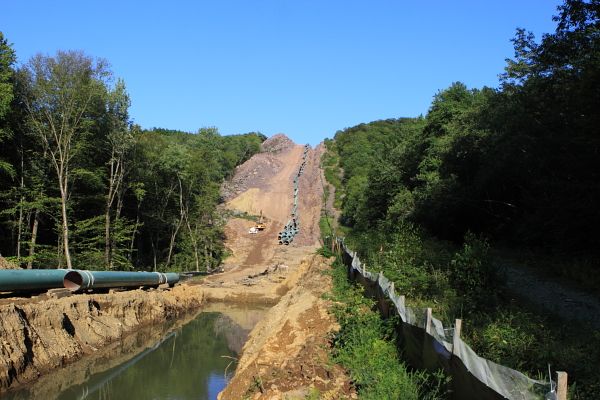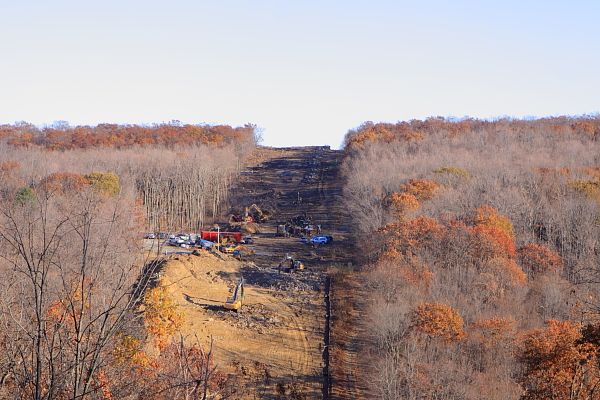Flood Hazard Rule Would Increase Allowable Sensitive Buffer Disturbance Limits
I’m surprised that given all the controversy over numerous gas and oil pipeline projects in New Jersey, that no on seems to have picked up on the fact that the Christie DEP’s proposed new Flood Hazard Act “stream encroachment” regulations would eliminate the current cap on “riparian zone” disturbance and increase allowable disturbance limits.
That outrageous rollback is not mentioned in the Legislative Veto Resolution either.
Existing Limits On Disturbance of the Buffer of a C1 Water by Pipelines
Specifically, under current stream encroachment permit rules, a pipeline crossing a category one stream with a 300 foot “riparian zone” would be allowed – for a “temporary disturbance only” – a maximum of 12,000 square feet of disturbance of vegetation (see Table C in this post).
That sets a cap on allowable disturbance. (exceedence triggers a 2/1 compensation requirement).
Proposed New Disturbance Limits
In contrast, under the proposed new Flood Hazard Act stream encroachment permit rules, the current 12,000 square foot maximum disturbance is replaced by a new standard, which would allow disturbance of 30 square feet per linear foot of pipeline. (see Table 11.2 in this post)
That proposed standard is a RATE, not a total limit on disturbance. (That appears to eliminate or reduce compensation requirements , obviously dependent on the site specific stream crossing)
Therefore, for example, a pipeline could follow a C1 stream for 3 miles, and be allowed to disturb a whopping 475,200 square feet! That’s 10.9 acres.
(5,280 feet/mile) X (3 miles) = 15, 840 linear feet X (30 square feet/linear foot) = 475,200 square feet
475,200 square feet)/43,560 square feet/acre – 10.91 acres
In addition to that, DEP would allow an additional 6,000 square feet of disturbance for access to the project, per crossing.
I’ve been told that the PennEast pipeline would cross 31 Category One streams (including tributaries) – so that means that for access alone, DEP would allow 186,000 square feet of disturbance (4.27 acres).
On top of all that, DEP proposes NO LIMITS at all for “reconstruction, upgrade, expansion, or maintenance” of an existing pipeline.
Finally, the concept of “temporary disturbance only” is eliminated, thus implying that DEP is allowing permanent disturbance.
Just when DEP should be developing methodologies to strictly enforce current stream buffer disturbance standards to protect NJ’s water quality from pipelines, the Christie DEP is proposing to repeal the Category One “Special Water Resource Protection Area” buffer rules, eliminate the cap on total disturbance under current stream encroachment rules, and increase allowable disturbance.
These rules could have been written by the pipeline lawyers – and very well may have been.
Curiously, the DEP “by invitation only” Stakeholder process webpage seems to omit the invited stakeholders for this rule.
[End note: for folks who like to understand the technical issues, the applicable regulations for a utility crossing are found at NJAC 7:13-11.9 (starting on page 126). Note that there is no requirement to comply with the anti degradation policy, surface water quality standards, or other restrictions on disturbance in the storm water rules SWRPA @ NJAC 7:8-5.5(h). DEP proposed to repeal those strong SWRPA which could authorize denial of a permit.
Also see NJ DEP’s Technical Manual – it provides maps of riparian zones and flood hazard areas and illustrations of how the rules apply to disturbance and stream crossings. It also provides revealing admissions that the stream encroachment rules are less protective than the C1 SWRPA buffer rules:
Note that any feature that meets the definition of a “swale” under the Freshwater Wetlands Protection Act rules at N.J.A.C. 7:7A- 1.4 is not regulated under the Flood Hazard Area Control Act rules and therefore has neither a flood hazard area nor a riparian zone. This is true because a swale, by definition, drains less than 50 acres and has no bed and banks, and therefore meets the requirements for a non-regulated water under N.J.A.C. 7:13-2.2(a)3.


